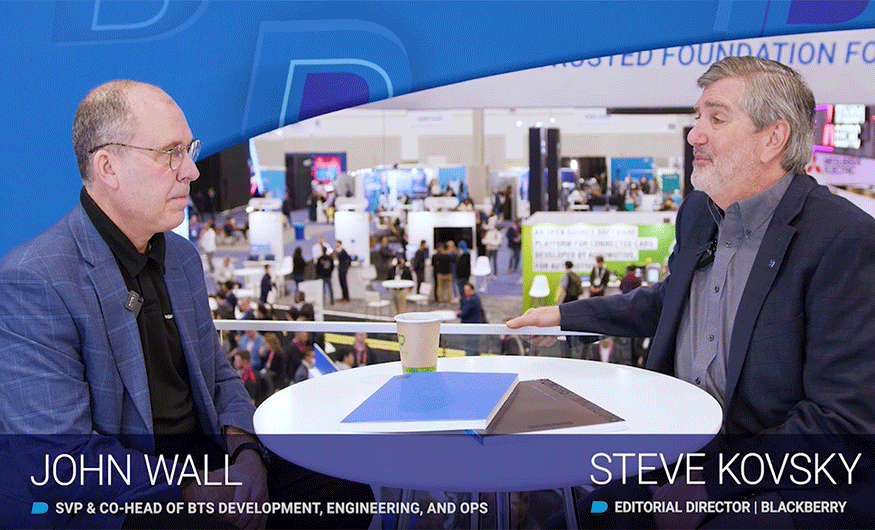How BlackBerry QNX Is Building Automotive’s Software-Defined Future

With today’s new cars, the quality of the driving experience is increasingly a function of the software built into the car. The more responsive and fully featured a vehicle’s software functions are, the greater enjoyment drivers will derive from it, and the more likely they will be to build a long-term connection with the brand.
As driving becomes more and more software-defined, the ability to harness and process data to optimize safety and drivability becomes paramount for carmakers to achieve success in their respective markets. Bringing together the ingredients for that success is the precise aim and life’s work of experts like John Wall, Senior Vice President and Head of QNX at BlackBerry.
Welcome to Season 2, Episode 3 of “Get In: The Software-Defined Vehicle Podcast from BlackBerry,” where we explore the possibilities created by — and technologies behind — today’s revolution in global transportation. In this episode, we visit the Consumer Electronics Show (CES) 2023 to meet Wall, as he explains how cutting-edge software platforms are providing the performance and features to delight drivers and propel the auto industry forward.
“If you think about the software-defined car, and the connection between the car and the cloud, there needs to be parity between what's happening on the car and the embedded systems in the car,” says Wall, who has been helping to define this technology sector since 1993.
Click to watch the full Season 2 Episode 3 podcast.
The upheaval in automotive architecture and design is also having a profound effect on the industry itself. “When you see how (car) companies are pivoting to become software companies, it's truly amazing,” says Wall. “It's an important story, and it's as big as electrification. It really isn't about the powertrain. It isn't about the seats. It's about the experience within the vehicle. That is going to be very important to carmakers going forward.”
This transformation is exemplified by the vehicle Wall himself recently purchased. “The car I bought was a dream of mine for many years,” he says. “It's a BMW M4 convertible. The thing that struck me is the experience within the cabin. The electronics, the digital instrument cluster, the personalization of the vehicle, the application that I have with it. That is really lightyears beyond what I've seen in vehicles just four or five years ago — a real evolution. The reality is, the software-defined portion of the vehicle isn't tied to being an EV or an ICE (internal combustion engine). It's about a complete experience within the vehicle.”
Providing a Safe Foundation for Software-Defined Excellence
“There's a lot of interest in what BlackBerry QNX is doing, more than I've ever seen,” says Wall, reflecting on his three decades of involvement with the software platform. “What we're doing is important to automotive: We provide that safe foundation for building the next-generation platform for the software-defined car.”
At CES®, BlackBerry announced that the QNX® OS for Safety has been made available on the AWS Marketplace. Users can now deploy QNX® Neutrino® RTOS as an Amazon Machine Image running on an Amazon EC2 instance, providing a virtual testbed for developers.
“Reducing developer friction is a big topic. Having QNX in the cloud allows you to develop software without having hardware on your desk,” Wall says.
“Everybody knows that the chip shortage has made it difficult to get hardware to work on at your desk,” says Wall. “Enabling QNX in the cloud allows easier testing, simulation, and digital twinning. It's a major feature that we're going to continue to evolve. We're going to move our tools into the cloud. This will reduce developer friction and make developing QNX easier.”
This will not only benefit existing QNX developers, but also encourage new engineers to enter the field, helping to address an urgent worldwide need for more automotive software developers. “It will allow us to grow our ecosystem of developers,” says Wall. “It will allow us to interact with universities more easily, to be able to give students access to our software in the cloud, to get them to learn how to use QNX. We want to grow that next generation ecosystem of developers for QNX.”
Pushing the Envelope for Automotive Experiences
Another announcement BlackBerry made at CES 2023 was regarding the May 2023 delivery date for the general availability of the BlackBerry IVY™ cloud-connected automotive AI platform, developed in partnership with Amazon Web Services. To accentuate the announcement, BlackBerry showcased the IVY™ platform’s capabilities with three commercially available platforms, delivered by Tier 1 automotive suppliers Bosch and PATEO, and AWS.
“The announcement of IVY’s integration with PATEO is particularly significant,” says Wall. As the first commercial deployment of IVY in new car models, it is a testament to how IVY can be harnessed immediately to deliver new and exciting advances in digital cockpit technology. “Our team is very passionate about building the best products. That drives us, and this industry acceptance is the reward for it.”
Spreading the Software-Defined Message and Honoring SDV Excellence
Wall’s extensive knowledge and deep passion for automotive technology has also been channeled in a new direction this past year, owing to his relationships with automotive publications such as Motor Trend, which BlackBerry collaborated with to launch the SDV Innovator Awards during CES 2023. “The Motor Trend team was great to work with,” he says. “They got it. It was an excellent idea to partner with MotorTrend.”
Wall sees the new SDV Awards program as a way to broadly share how important software – and the efforts of innovative software developers — has become in redefining the transportation field, and delivering the most valuable new features in the latest vehicle designs. “This is a way to start raising the profile of what we're doing within the car and how important it is,” he says. “Consumers see an evolution of features in the vehicle, but they don’t know what's going on behind the scenes and how dramatic it is to the industry.”
Just the Beginning
What does Wall think is coming next? “We're going to see more software-defined features around safety,” he says. “That's going to be a big evolution.”
While global excitement around fully autonomous driving remains high, the near-term focus is on perfecting higher and higher levels of assisted driving, based on “safety systems where the driver is still in control. If you go back a few years at CES, the big buzz was fully autonomous ‘level five’ driving. But that has been scaled back and focused on the safety of the vehicle,” Wall says.
“The other thing we're going to see is data playing a bigger role. You're going to start seeing the carmakers leveraging more data from the vehicle to provide a better experience from a maintenance perspective, from a warranty perspective, and from applications and features that will be delightful to the customer.
“We know that safety is incredibly important in the car,” adds Wall. “We also know that security is incredibly important. In these respects, the QNX operating system hypervisor and our middleware are the best in the world. But in the coming years, we see more and more high-performance, cloud-like computing moving into the car.”
Laying the Groundwork for Tomorrow’s SDVs
“We have a next-generation microkernel coming out called ‘Muon.’ The whole point of this is to provide the scalability for the powerful new CPUs that we're going to find in the car,” Wall says. “The idea here is to provide safety, security, and the highest performance available. We believe we'll have the fastest RTOS (real-time operating system) on the planet, which will carry us into the next generation of vehicles.”
Wall sees the main competition for automotive RTOS dominance playing out between Linux® variants and BlackBerry® QNX® — a competition QNX is currently winning. But he refuses to be complacent.
“We don’t want to sit on our laurels,” he says. “We have a dominant position, but we know there are people hungry to get into this space. We know there are lots of advocates of other solutions. We want to make sure that we can control the things that we can control. This means providing the best experience to developers. A lot of that is with our cloud initiative, but we are also providing the best performance within the vehicle, while maintaining safety and the highest level of security.”
The key to supporting higher performance in an automotive RTOS, Wall says, is taking advantage of the latest developments in processors.
“When the operating systems were designed initially, you had CPUs that had two, maybe four cores,” says Wall. “Now we're talking about CPUs that will have eight cores, 16 cores, 32 cores. We need to make design changes to efficiently support the scaling of these systems. The next evolution of our product today runs on those chips. We've just made some fine-tune updates to our product to make sure that we take advantage of all the performance that’s available from the latest hardware.
“This will enable support for the next generation of software-defined vehicles and our cloud initiative,” concludes Wall. “Cloud compute is going to take advantage of this. It's going to be foundational to all our products — the operating system, and the hypervisor and safety products.
What’s the major takeaway for BlackBerry QNX this year? “Anybody looking to build a software-defined vehicle — which is everybody — should take a serious look at our products. We're making a lot of investments. We're hiring a lot of people and growing the business. We are laser-focused on safety and security, as well as performance. It's our mission to provide the safest possible systems within the car.”
Click below to listen to Season 2, Episode 3 of “Get In: The Connected Vehicle Podcast From BlackBerry.”
For similar articles and news delivered straight to your inbox, subscribe to the BlackBerry Blog.
Related Reading
- Get In (Season 2, Episode 2): How EV Battery Analytics Can Improve the Driving Experience
- Get In (Season 2, Episode 1): The Future of Automotive’s Intelligent Edge: Executive Update on The Latest Trends from BlackBerry
- Get In (Season 1, Episode 12): Recognizing the Trailblazers of Software-Defined Vehicle Technology With New MotorTrend Awards Program
- Software-Defined Vehicles and Their Role in Smart Cities
